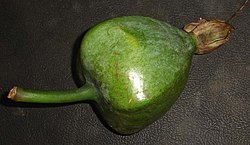Barringtonia asiatica
Barringtonia asiatica, also known as fish poison tree, putat or sea poison tree, is a species of Barringtonia native to coastal habitats from islands of the Indian Ocean in the west to tropical Asia and islands of the western Pacific Ocean.
Description
It is a small to medium-sized tree growing to 7–25 m tall. The leaves are narrow obovate, 20–40 cm in length and 10–20 cm in width. Its fruit is known as box fruit, due to distinct square like diagonals jutting out from the cross section of the fruit. It has a semi-spherical shape at the stem, altering to a subpyramidal shape at its base. The fruit measures 9–11 cm in diameter, where a thick spongy fibrous layer covers the 4–5 cm diameter seed.
Taxonomy
This species was first described in 1753 as Mammea asiatica by Carl Linnaeus, based on material collected from Java by Pehr Osbeck, a Swedish naturalist and one of Linnaeus' apostles. It was transferred to the genus Barringtonia by the German botanist Wilhelm Sulpiz Kurz in 1875. A number of other botanists have collected specimens of this plant and described them under different names, all of which are now recognised as synonyms (see synonyms list).
Etymology
The genus name was created to honour the English lawyer, antiquary and naturalist, Daines Barrington, while the species epithet asiatica refers to the region where this species is found.
Distribution
Barringtonia asiatica is native to tropical coastlines from Tanzania and Madagascar to India, Southeast Asia, Australia, the Solomon Islands, New Caledonia, Fiji and many other islands of the western Pacific Ocean. It inhabits beaches and coastal forests. It has been introduced to the Cayman Islands, Cuba, Dominican Republic, Haiti, the Leeward Islands, Puerto Rico, Trinidad-Tobago and the Windward Islands.
Ecology
The fruit is dispersed in the same way as a coconut – by ocean current – and is extremely water-resistant and buoyant. It can survive afloat for up to fifteen years;[failed verification] it was one of the first plants to colonise Anak Krakatau when this island first appeared after the Krakatau eruption. When washed ashore, and soaked by rainwater, the seeds germinate.
Uses
All parts of the tree are poisonous, the active poisons including saponins. Box fruits are potent enough to be used as a fish poison. The seeds are ground to a powder and used to stun or kill fish for easy capture, suffocating the fish while the flesh is unaffected.
Gallery
- Illustration from Flora de Filipinas by Francisco Manuel Blanco
- Immature fruit (about fist size)
- Flower


